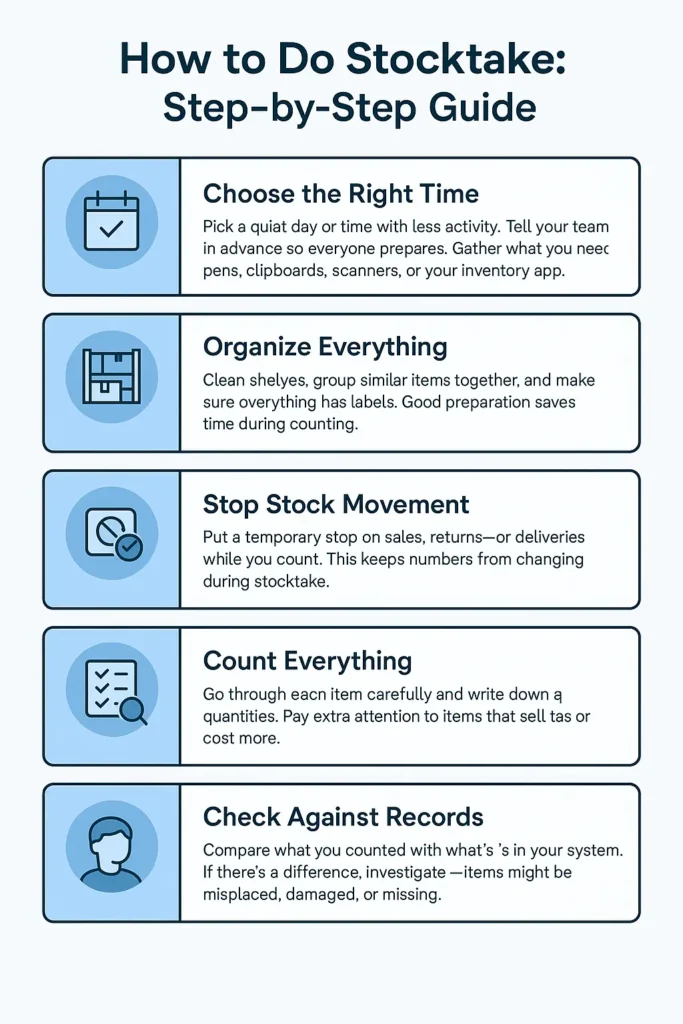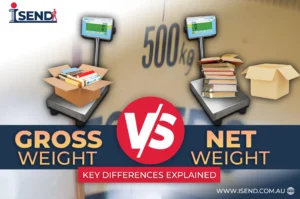Have you ever ordered something online and received a “sorry, sold out” email? Those problems often come from poor stocktake practices. Research shows 21% of consumers lose trust in a brand after a late delivery, and 23% refuse to buy again. A solid stocktake prevents these costly mistakes, making stocktake essential for every retailer, wholesaler, and e-commerce brand.
What Is Stocktake?
A stocktake is when a business counts everything in stock, from products on shelves to items in warehouses. Companies do this to ensure their system numbers match what they actually have. This process helps find missing, damaged, or extra items and keeps records accurate. Regular stocktakes make it easier to plan orders, avoid running out of popular items, and keep businesses running well.
Stocktake Definition and Meaning in Retail
In retail and wholesale supply chains, stocktake means the systematic physical count and verification of every product (SKU) in a location. Accurate counts create reliable financial statements, loss-prevention programs, and customer-friendly order fulfillment.
Quick fact: If your trading stock value changes by ≤ A$5,000 across a financial year, the Australian Taxation Office’s simplified stock rules let many small businesses skip formal stocktakes and save time.
Why Stocktake Matters for Every Business
Financial Accuracy
Updated counts keep your balance sheet inventory from being over or understated.
Loss Prevention
Regular checks highlight shrinkage (theft, damage, picking errors) early.
Better Decision Making
Knowing exact stock levels prevents over-buying and stock-outs.
Legal Compliance
The ATO and auditors require verifiable inventory records. Fines cost more than a day of counting.
Better Operations
Reliable data lets your warehouse management system route pickers, replenish stock locations, and forecast demand without guesswork.
How Stocktake Works
At its core, stocktake compares system quantity with physical quantity and fixes any differences. The process follows five steps:
- Freeze stock movements (or isolate the counted area)
- Count each product (scan or tally)
- Record counts on a stocktake sheet or app
- Check differences—picking errors, wrong locations, theft
- Update records and reopen stock
How to Do Stocktake: Step-by-Step Guide

Step 1: Choose the Right Time
Pick a quiet day or time with less activity. Tell your team in advance so everyone prepares. Gather what you need: pens, clipboards, scanners, or your inventory app.
Step 2: Organize Everything
Clean shelves, group similar items together, and make sure everything has labels. Good preparation saves time during counting.
Step 3: Stop Stock Movement
Put a temporary stop on sales, returns, or deliveries while you count. This keeps numbers from changing during stocktake.
Step 4: Count Everything
Go through each item carefully and write down quantities. Pay extra attention to items that sell fast or cost more.
Step 5: Check Against Records
Compare what you counted with what’s in your system. If there’s a difference, investigate—items might be misplaced, damaged, or missing.
Step 6: Finish Up
Share results with your team or manager and note any changes needed for ordering, storage, or security.
You can download a stocktake template from Microsoft to help organize your counts.
Stocktaking Methods: Periodic vs Perpetual
| Method | Best For | Pros | Cons |
|---|---|---|---|
| Periodic stocktake (monthly/quarterly/annual) | Low-SKU boutiques, cafés | Cheap; no tech needed | Must pause operations; data can go stale |
| Perpetual stocktake (real-time) | High-volume e-commerce, 3PLs | Always accurate; minimal shutdowns | Needs scanners, integrated systems, and staff discipline |
For more depth on the perpetual approach, see Investopedia’s guide to the perpetual inventory system.
Benefits of Stocktake
Doing a stocktake might feel like a big job, but the benefits make the effort worthwhile. Stocktake isn’t just about counting boxes—it’s about keeping your business in control and running well.
Keeps Records Real
Systems can say one thing, but what’s on your shelves might tell a different story. Stocktake helps you match the two so you know exactly what’s in your warehouse or shop.
Smarter Buying Decisions
When you know what’s in stock, you can avoid panic orders or buying more than you need. That means less waste and better use of your budget.
Spots Problems Early
Missing items? Damaged goods? Numbers that don’t add up? Stocktake shines a light on these issues before they grow into bigger, costlier problems.
Protects Your Cash
Every item on your shelves represents money. By keeping the right amount of stock, you stop cash from being tied up in products that just collect dust.
Keeps Customers Happy
When stock records are accurate, you can deliver orders on time and avoid disappointing customers with “out of stock” messages.
Helps with Reports and Audits
If you need to provide figures for accounting or tax purposes, stocktake gives you up-to-date, reliable data without guesswork.
Risks of Performing Stocktake
Stocktake is an important part of running a business, but the process can bring its own challenges if you’re not prepared. Think of stocktake as a necessary task—valuable in the long run, but a little tricky in the moment.
Operations Slow Down
To count everything properly, you often need to pause sales, deliveries, and returns. If this happens during a busy period, customers might get annoyed or face delays.
Mistakes Happen
No matter how careful you are, people can miscount, skip items, or record numbers wrong—especially if stock isn’t well organized.
Takes Time and Money
Stocktake can be a big job, sometimes needing extra staff or overtime hours. That means extra costs on top of the time needed to get the job done.
Physical Demands
In a big warehouse or store, you might be lifting, moving, and bending for hours. Without proper care, that can be exhausting or even cause injuries.
New Errors Can Appear
If final numbers aren’t entered into the system correctly, your records might end up less accurate than before you started.
Security Risks
When products are being handled and moved around, there’s a small window where items can go missing if things aren’t closely watched.
Stocktake Sales & Retail Events
In Australia, a stocktake sale is the clearance event that follows End of Financial Year (EOFY) on June 30—shoppers love the bargains, accountants love a fresh ledger. The ABC offers a helpful explainer on why EOFY is peak discount season.
When Do Stocktake Sales Start?
Most national chains open their stocktake sales in late May or early June, peaking in the first week of July.
Myer Stocktake Sale 2025 – Key Dates
| Event | Start | End | Channel |
|---|---|---|---|
| Preview offers | 26 May 2025 | 2 Jun 2025 | Online only |
| Main sale window | 3 Jun 2025 | 7 Jul 2025 | In-store & online |
| Final markdowns | 5-7 Jul 2025 | 7 Jul 2025 | In-store |
For real-time updates on when the Myer stocktake sale ends in Australia, bookmark the official Myer EOFY sale page.
Retailers beyond Myer—like David Jones, JB Hi-Fi, Bunnings—run similar stocktake sales, so fulfillment centers should prepare for a June-July volume spike.
Difference Between Stocktaking and Inventory Management
Stocktaking – a snapshot physical count at a specific time.
Inventory management – an ongoing strategy that forecasts demand, automates reordering, places fast-moving products, and analyzes turnover. Stocktake feeds inventory management with fresh, trustworthy data.
How Often Should You Perform Stocktake?
How often you should do stocktake depends on the type of business you run and how fast your stock moves. Many businesses choose to do a full stocktake once or twice a year, often at the end of the financial year for accurate reporting.
Others, especially those with high turnover or valuable items, do stocktakes quarterly or even monthly. Some companies also run smaller, more frequent “cycle counts” on specific products to keep things accurate without shutting down operations for a full count.
💡 Real User Discussion:
“Taking inventory (a stock take) allows you to report your finances (specifically, your inventory, an asset) correctly for financial reporting and tax purposes. ” (from Reddit user)
Source: [Link to the Reddit discussion]
Recommended Frequencies:
Perpetual environments – cycle-count high-value products daily and run a full physical audit annually.
Mid-size stores – quarterly counts plus monthly spot checks.
Low-turnover shops – an annual stocktake may work, but plan monthly shrinkage scans for safety.
The key is to find a schedule that keeps your inventory records reliable while fitting with your day-to-day business operations.
Common Stocktaking Challenges & Solutions
| Problem | Root Cause | Fix |
|---|---|---|
| Miscounts & data errors | Manual tally sheets | Barcode or RFID scanning, double-checker pairs |
| Shrinkage (theft, damage) | Poor security | CCTV, tamper-evident seals, staff training |
| Trade disruption | Counting during peak hours | Schedule counts after close or during slow periods |
| Ledger mismatch | Delayed system updates | Integrate inventory system with POS/warehouse system for real-time sync |
Special Types of Stocktake
Lightspeed Stocktake
Lightspeed is a popular retail point-of-sale system that includes stocktake features. The Lightspeed stocktake function lets retailers count inventory directly through their POS system, making the process more efficient and reducing errors.
Global Stocktake
In environmental terms, global stocktake refers to a comprehensive assessment process under the Paris Agreement where countries review progress on climate action every five years. While not related to business inventory, this term appears in international climate discussions.
Jewish Stocktake
Outside retail, some Jewish communities use “stocktake” to describe a spiritual self-audit (cheshbon ha-nefesh) before Yom Kippur. This practice involves taking stock of one’s actions and spiritual state over the past year.
Stocktake Templates and Tools
📥 Download stocktake_template.xlsx
Essential Stocktake Sheet Elements
A good stocktake sheet includes:
- Product name and SKU
- Location (bin, shelf, aisle)
- System quantity
- Counted quantity
- Variance column
- Notes section
- Counter initials
- Date and time
Digital vs Paper Templates
Digital templates offer advantages like automatic calculations, easier sharing, and better organization. However, paper templates work well for small businesses or areas without reliable internet access.
Technology Solutions for Stocktake
Barcode Scanning
Barcode scanners speed up the counting process and reduce human error. Most modern inventory systems support barcode scanning for stocktake.
RFID Technology
Radio Frequency Identification (RFID) tags allow for even faster counting, as multiple items can be scanned simultaneously without direct line of sight.
Mobile Apps
Many inventory management systems now offer mobile apps that turn smartphones or tablets into stocktake tools, combining scanning capabilities with easy data entry.
Frequently Asked Questions
What does stocktake mean?
A stocktake is a point-in-time physical inventory count that matches your books with what is actually on the shelf.
How does stocktake work in a café?
Freeze sales, scan each item, fix differences, then reopen point-of-sale system—usually done after hours to avoid revenue loss.
Why is stocktake important beyond accounting?
Stocktake highlights fast-moving products, slow stock, and shrinkage, letting managers act before cash is lost.
What does Jewish stocktake refer to?
Outside retail, some Jewish communities use “stocktake” for a spiritual self-audit (cheshbon ha-nefesh) before Yom Kippur.
How often should stocktake be done in e-commerce?
Cycle-count daily and run a quarterly full count if you ship 1,000+ orders per month.
Conclusion
A disciplined stocktake supports profitable, customer-friendly operations. By choosing the right method, using digital tools, and taking cues from events like the Myer Stocktake Sale 2025, you’ll reduce shrinkage, keep auditors happy, and delight shoppers with every on-time delivery.
Next step: Download a free stocktake template and integrate it with courier booking systems to turn perfect counts into perfect deliveries.








